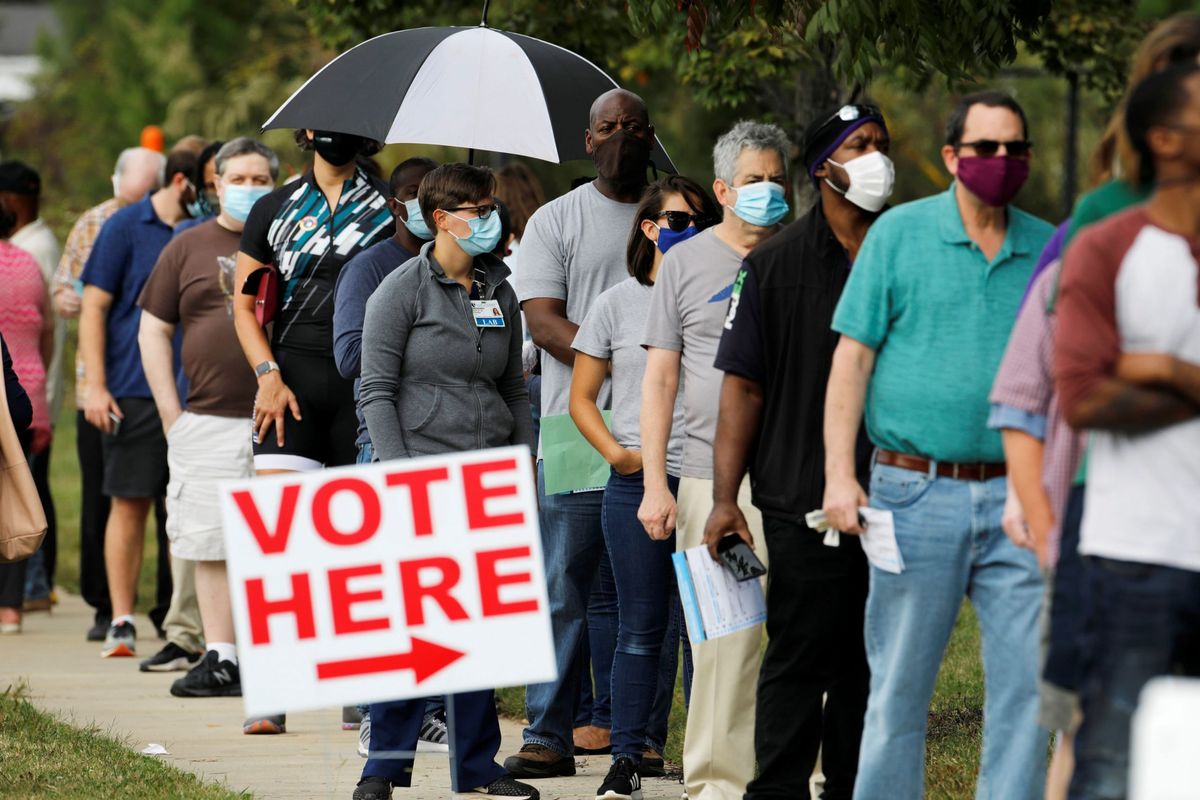How accurate were the state polls in the 2020 election?

A few minutes every morning is all you need.
Stay up to date on the world's Headlines and Human Stories. It's fun, it's factual, it's fluff-free.
Despite assurances that polling was the best election predictor available, going into Election Day voters still felt uncertain about how things would play out.
In 2016, the victory of President Donald Trump in the United States caught many off guard and seemed to prove that election polling was obsolete. Prior to Election Day, polling aggregation websites like FiveThirtyEight seemed to all but guarantee that Trump was heading for a loss. It didn’t matter that pollsters all warned that Trump still had a statistical shot. The narrative was established: polls can’t be trusted.
Nevertheless, in the post-mortem of the 2016 election, pollsters repeatedly insisted that the polling was, in reality, accurate, at least if looked at on a macrolevel. Or as Nate Silver, founder of FiveThirtyEight, put it in 2018, “National polls were pretty good in the 2016 presidential election, but state-level polling was fairly poor (although still within the “normal” range of accuracy).”
In terms of the popular vote, the polling was well within the margin of error. For instance, the final election forecast from FiveThirtyEight in 2016 projected that former Secretary of State Hillary Clinton would receive 48.5% of the vote compared to Trump’s 44.9%. In the final vote, Clinton received 65,853,514 votes (48.2%) and Trump received 62,984,828 votes (46.09%).
Yet, FiveThirtyEight also projected Clinton would win the electoral college with 302 electors to Trump’s 235. Instead, Trump netted 304 electoral votes and Clinton only 227 (after 10 “faithless electors” cast their votes for other candidates). FiveThirtyEight’s projections, like most election predictions, were based on the assumption Clinton would carry states she ultimately did not.
The 2018 midterm elections suggested that the polls had rebounded from the black eye they’d received in 2016. Yet, Trump hadn’t been on the ballot in 2018, so it didn’t feel like an accurate gauge of polling accuracy in an election year. Some speculated that the reluctance of Trump supporters to speak to pollsters would once again skew the polling.
Despite assurances that polling was the best election predictor available, going into Election Day voters still felt uncertain about how things would play out.
The 2020 election results
Heading into Election Day 2020, the country faced a situation very similar to 2016. Trump was behind in the polls and appeared to be set for a bad loss. Yet, it was known that Election Day would not be the end of the story, with Democrats overwhelmingly voting early and by mail, which could result in days or even weeks for all the ballots to be counted.
As it turned out, it took several days before news agencies called the election in favor of President-elect Joe Biden. Since then, Trump and his legal team have spent weeks claiming, without evidence, that there was massive voter fraud. Regardless of those claims, it has been clear for a while now that Biden has, like Clinton, won the popular vote.
In their final projection, FiveThirtyEight predicted Biden would receive 53.4% of the national vote, compared to Trump’s 45.4%. While votes are still being counted, the current total according to the Cook Political Report sits at 80,259,147 votes (51.1%) for Biden and 73,967,466 votes (47.1%) for Trump. Again, that puts the final prediction within reasonable proximity of the total.
The more interesting question has always been whether state polls would be accurate in 2020. Many of the most closely contested states have either had recounts or legal fights to block them from being certified. However, with the vote totals certified in Michigan, Georgia and Pennsylvania officially giving Biden enough electoral votes to win the election, it’s now possible to get a fuller picture of how state polls did this year.
How accurate was polling in swing states?
On November 9, FiveThirtyEight’s Silver tweeted a preliminary look at swing state polling, noting that on average the polling had underestimated Trump by 3.3 points. He adds the caveat, though, that most of the biggest polling errors occurred in non-swing states, which “didn’t tend to attract a lot of high-quality polling.”
For instance, in a state like Oklahoma that was expected to go to Trump, the more highly rated polling agencies don’t tend to spend a lot of time and resources. Therefore, election predictions must rely on less reliable pollsters.
Now that final count totals are known in almost all the states, it’s possible to give an even more accurate assessment of how the swing state polling did in 2020. Here are some of the most revealing results. (Note: legal fights and faithless electors could still alter the final election results.)
Georgia
Up until the week before Election Day, FiveThirtyEight projected Trump had the lead in Georgia, a state that hadn’t been won by a Democratic candidate since President Bill Clinton won it in 1992. Yet, a late surge of positive polling for Biden suddenly flipped the state in the site’s forecasts. On Election Day, FiveThirtyEight predicted Biden would win the state 50.1% to 49.2%.
Befitting such a close prediction, based on high-quality pollsters like Monmouth University and Emerson College, it is no wonder the state took extra time to certify its results, following a recount. The final count resulted in 2,474,507 votes (49.5%) for Biden and 2,461,837 votes (49.3%) for Trump. All in all, the polling prediction was remarkably close to the final results.
Florida
Unlike Georgia, Florida is a longtime swing state, having swung back and forth between voting Republican and Democrat for decades. Though Trump won the state in 2016, FiveThirtyEight consistently had Biden favored to win the state throughout the year. Their final prediction had Biden winning the state’s popular vote, 50.9% to 48.4%.
As it turned out, Florida wound up being one of the biggest misses for state polling, in large part because Trump outperformed with Latino voters there. The final result was 5,668,731 votes (51.2%) for Trump and 5,297,045 votes (47.9%) for Biden. Trump has not received much good news in the days following Election Day, but his victory in Florida was a brief reason for celebration.
Of the final major polls in Florida, all but one projected a Biden victory. Only the ABC News/Washington Post poll released on November 1 had Trump leading, albeit within the margin of error.
Ohio
Ohio was another state that looked like it could go either way as Election Day approached. The lead in the state had vacillated between Trump and Biden for weeks. FiveThirtyEight’s final projection had Trump narrowly beating Biden in the popular vote, 49.8% to 49.2%.
While that projection did correctly call Trump’s win in Ohio, the margin wasn’t nearly that close. In the final count, Trump earned 3,153,751 votes (53.3%) to Biden’s 2,678,528 votes (45.3%). Trump’s substantial margin of victory wasn’t the only interesting turn out of the state. For the first time since 1960, the winner of Ohio did not go on to win the national election.
Iowa
For most of 2020, Trump was favored to win the Midwest state of Iowa. As Election Day approached, though, the FiveThirtyEight projection narrowed, though it still remained slightly in Trump’s favor: 50% to 48.5%.
Again, the state polling accurately predicted the victor, but not quite the percentages. The final count resulted in Trump winning with 897,672 votes (53.2%), beating Biden’s 759,061 votes (45%). Notably, in the last week of the election, there was only one A+ rated poll in Iowa: Selzer & Co, which projected a 7% victory for Trump.
Arizona
One early indicator that Biden was going to pull out a national victory was his early strong numbers out of Arizona, a state Trump won by four points in 2016. The last two months of the election saw Biden open up a substantial polling lead in the state, with FiveThirtyEight projecting a 50.7% to 48.1% win for the former vice president. Arizona hadn’t voted for a Democratic since 1996.
On Election Day, Arizona’s numbers favored Biden, but in the subsequent days that followed, the vote narrowed considerably. Trump and his legal team initially attempted a legal fight in Arizona, but it was one of the first states where they gave up their efforts. In the end, the vote margin was incredibly narrow, but Biden held on for the victory, 1,672,143 votes (49.4%) to 1,661,686 votes (49.1%).
While these five states offer only a snapshot of the entire election, they do provide a diverse enough sample to see state polling had its weaknesses this year. That’s not to suggest that the polling was inaccurate – far from it nationally and in many states – only that the methodologies still have room for improvement.
Have a tip or story? Get in touch with our reporters at tips@themilsource.com




Comments ()